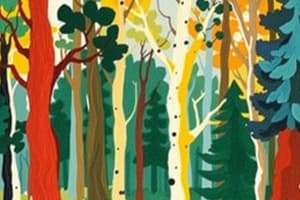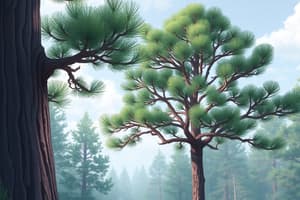Podcast
Questions and Answers
Which of the following best describes the primary focus of dendrology?
Which of the following best describes the primary focus of dendrology?
- The study of insects that inhabit trees.
- The study of the effects of climate change on forest ecosystems.
- The study of the chemical processes within plant cells.
- The study of woody plants, including trees, shrubs, and woody vines. (correct)
Which characteristics are typical of woody plants?
Which characteristics are typical of woody plants?
- A stem that is above ground, covered in thickened bark, and exhibits continuous vegetative growth above ground from year to year. (correct)
- A stem that only grows for a single season and then produces seeds before dying.
- A stem that grows entirely underground and lacks bark.
- A flexible stem that dies back to the ground each winter.
Lignin and cellulose are molecules primarily found in wood, and contribute which of the following to the plant?
Lignin and cellulose are molecules primarily found in wood, and contribute which of the following to the plant?
- Structural support and a system for transporting water and nutrients. (correct)
- Regulation of photosynthesis and storage of genetic information.
- Defense against herbivores and attraction of pollinators.
- Absorption of sunlight and exchange of gases.
How does dendrology relate to the fields of botany and forestry?
How does dendrology relate to the fields of botany and forestry?
Which of the following is encompassed by the study of dendrology?
Which of the following is encompassed by the study of dendrology?
What do dendrologists study about woody plants?
What do dendrologists study about woody plants?
How might the USDA Forest Service utilize dendrology?
How might the USDA Forest Service utilize dendrology?
How do wildlife biologists benefit from studying dendrology?
How do wildlife biologists benefit from studying dendrology?
What does the study of the natural history of an area, in the context of dendrology, include?
What does the study of the natural history of an area, in the context of dendrology, include?
What role does dendrology play in global forestry?
What role does dendrology play in global forestry?
Why is identifying tree species important in wetland management?
Why is identifying tree species important in wetland management?
Which option lists ways that woody plants are important to the world?
Which option lists ways that woody plants are important to the world?
What can be gained from studying dendrology?
What can be gained from studying dendrology?
According to the provided definition, what minimal height must a woody plant have at maturity to be considered a tree?
According to the provided definition, what minimal height must a woody plant have at maturity to be considered a tree?
What is the minimum diameter of the single trunk required for a woody plant to be classified as a tree?
What is the minimum diameter of the single trunk required for a woody plant to be classified as a tree?
What is the standard height at which the diameter of a tree trunk is measured, often referred to as 'breast height'?
What is the standard height at which the diameter of a tree trunk is measured, often referred to as 'breast height'?
Which of the following best describes the 'crown' of a plant?
Which of the following best describes the 'crown' of a plant?
What is the significance of the Angel Oak in the context of dendrology and tree appreciation?
What is the significance of the Angel Oak in the context of dendrology and tree appreciation?
Which of the following statements accurately describes a notable characteristic of the Angel Oak?
Which of the following statements accurately describes a notable characteristic of the Angel Oak?
Why are trees described as inspiring a feeling of wonder and excitement?
Why are trees described as inspiring a feeling of wonder and excitement?
Why is the distinction between trees and shrubs considered not always clear?
Why is the distinction between trees and shrubs considered not always clear?
How can a species like poison-sumac exemplify the unclear distinction between trees and shrubs?
How can a species like poison-sumac exemplify the unclear distinction between trees and shrubs?
What is a key characteristic of vines, as distinguished from trees and shrubs?
What is a key characteristic of vines, as distinguished from trees and shrubs?
What differentiates a 'liana' from other types of vines?
What differentiates a 'liana' from other types of vines?
Which of the following is an example of a liana found in temperate regions?
Which of the following is an example of a liana found in temperate regions?
What does 'habit' refer to in the context of botany and zoology?
What does 'habit' refer to in the context of botany and zoology?
What are the three main habits of woody plants?
What are the three main habits of woody plants?
What is a habitat?
What is a habitat?
According to the information, what factors make up a habitat?
According to the information, what factors make up a habitat?
How does the definition of habitat apply to parasitic organisms?
How does the definition of habitat apply to parasitic organisms?
What is ecology?
What is ecology?
Considering the definition of ecology, which of the following would an ecologist study?
Considering the definition of ecology, which of the following would an ecologist study?
How might dendrology contribute to the study of ecology?
How might dendrology contribute to the study of ecology?
Which of the following examples illustrates the application of dendrology in wetland management?
Which of the following examples illustrates the application of dendrology in wetland management?
How does dendrology contribute to understanding the natural history of a region?
How does dendrology contribute to understanding the natural history of a region?
Flashcards
Dendrology
Dendrology
The study of woody plants, including trees, shrubs, and woody vines.
Woody Plant
Woody Plant
Any plant that has wood, composed primarily of cellulose and lignin.
Dendrology's Scope
Dendrology's Scope
A sub-discipline of botany and forestry focused on the systematics, morphology, ecology, and natural history of woody plants.
USDA Forest Service and Dendrology
USDA Forest Service and Dendrology
Signup and view all the flashcards
Wildlife Biologists and Dendrology
Wildlife Biologists and Dendrology
Signup and view all the flashcards
Natural History of an Area
Natural History of an Area
Signup and view all the flashcards
Global needs of Forestry
Global needs of Forestry
Signup and view all the flashcards
Wetland Management
Wetland Management
Signup and view all the flashcards
Importance of Woody Plants
Importance of Woody Plants
Signup and view all the flashcards
Tree Definition
Tree Definition
Signup and view all the flashcards
DBH
DBH
Signup and view all the flashcards
Crown (of a plant)
Crown (of a plant)
Signup and view all the flashcards
Trees
Trees
Signup and view all the flashcards
Angel Oak
Angel Oak
Signup and view all the flashcards
Shrub Definition
Shrub Definition
Signup and view all the flashcards
Vine Definition
Vine Definition
Signup and view all the flashcards
Habit
Habit
Signup and view all the flashcards
Habitat
Habitat
Signup and view all the flashcards
Ecology
Ecology
Signup and view all the flashcards
Study Notes
Introduction to Dendrology
- Dendrology is the study of woody plants, including trees, shrubs, and woody vines.
- A woody plant is any plant that has wood.
- Wood is primarily composed of cellulose and lignin molecules.
- Cellulose and lignin provide support and facilitate the movement of water, nutrients, and sugars throughout the plant.
- Woody plants typically have an above-ground stem covered by a layer of thickened bark and continue vegetative growth above ground from year to year.
Dendrology as a Sub-Discipline
- Dendrology is a sub-discipline of botany and forestry.
- It deals with systematics (including nomenclature), morphology, phenology, ecology, geographic range, and natural history.
Dendrologists
- Dendrologists study woody plant names, habits, ranges, habitats, and distinguishing characteristics.
Modern Dendrology Applications
- The USDA Forest Service uses dendrology for comprehensive management of sustainable and productive forests and related natural resources.
- Wildlife biologists use dendrology to learn how and which trees provide cover, nesting sites, and food for various wildlife.
- Natural history includes the knowledge of edible or poisonous plants and their practical uses by people.
- Global forestry requires knowledge of international trees in terms of their economic uses, conservation, and management.
- Wetland management relies on identifying tree species indicative of wetlands.
Importance of Woody Plants
- Woody plants provide food, shelter, shade, and fuel.
- They produce wood, oxygen, absorb carbon dioxide, and control erosion.
Course Objectives
- The course aims to teach plant identity, relationships, life history, habitats, distribution, uses, and other qualities.
- It intends to expand powers of observation, discrimination, conceptualization, and general curiosity.
Tree Definition
- A tree is a woody plant that reaches at least 13 feet in height at maturity.
- Trees generally have a single trunk at least 3 inches in diameter when measured at breast height (4 1/2 ft or 137 cm), which is unbranched for several feet above the ground, and have a definite crown.
- A crown includes all aboveground parts of the plant, including stems, leaves, and reproductive structures.
Mature Tree Sizes
- Measurements are taken at diameter at breast height (dbh).
- Breast height is standardized at 4 1/2 feet (137 cm).
Angel Oak
- The Angel Oak is a Live Oak (Quercus virginiana) native to the Lowcountry of Coastal Carolina.
- It is believed to be over 1500 years old.
- The Angel Oak is named after previous owners, Martha and Justin Angel.
- The Angel Oak has a wide spread canopy but is not very tall, standing at 65 feet.
- The Angel Oak has a circumference of 25.5 feet.
- The Angel Oak has a diameter of 160 feet.
- The leaves provide an area of shade measuring 17,000 square feet.
- The longest limb measures 89 feet.
- The largest limb circumference measures 11.25 feet.
- Some of limbs are so large and heavy that they rest on the ground, and can even drop underground for a few feet and then come back up.
Perspective
- The size, age, shape, dominance, beauty, and potential uses of trees evoke feelings of wonder and excitement.
Distinctions Among Trees, Shrubs, and Vines
- The difference between trees and shrubs is subjective.
- Poison-sumac is a shrub in the Great Lakes but can grow into a 25-foot tree in Georgia.
- Plant species may be shrubby near the edges of its range but still have large proportions elsewhere.
- Several woody plant species start as vines and then become shrubs as they mature.
- Some shrubs may exhibit vine-like characteristics at the ends of long branches.
Definitions of Shrubs and Vines
- Shrubs are smaller than trees.
- Shrubs usually have several erect, spreading, or prostrate stems and a general bushy appearance.
- Vines climb and can be woody or herbaceous.
- Herbaceous vines have little to no woody tissue and typically persist for a single growing season.
- Lianas are woody vines.
- Temperate regions contain liana species, including wild grape, moonseed, trumpet creeper, crossvine, greenbrier, poison-ivy, and Virginia creeper.
Habit
- Habit, in botany/zoology, refers to the general appearance of an organism.
- The three main plant habits for woody plants are tree, shrub, and liana.
- There are subgroups of habits within these three main types.
Habitat
- Habitat refers to the area or natural environment in which an organism or population normally lives.
- A habitat consists of physical factors, like soil, moisture, temperature, and light, coupled with biotic factors, like food availability and the presence of predators.
- A habitat is not always a geographic area; for parasites, it could be the host's body or even a cell within it.
Ecology
- Ecology is the branch of biology dealing with the relationships and interactions between organisms and their environment, including other organisms.
Studying That Suits You
Use AI to generate personalized quizzes and flashcards to suit your learning preferences.




